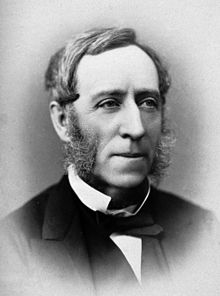Richard Quain
|
Sir Richard Quain |
|
|---|---|

Sir Richard Quain in 1881
|
|
| Born |
30 October 1816 Mallow, County Cork |
| Died | 13 March 1898 (aged 81) |
| Nationality | Irish |
| Alma mater | University College, London |
| Occupation | Physician |
| Known for | Quain's Dictionary of Medicine |
Sir Richard Quain, 1st Baronet (30 October 1816 – 13 March 1898), was an Irish physician.
He was born at Mallow-on-the-Blackwater, County Cork, and died in Harley Street, London.
Quain was the eldest child of John Quain of Carrigoon and Mary, daughter of Michael Burke of Mallow. He was sent to the Diocesan School at Cloyne for his early education and then, aged 15, apprenticed to the surgeon-apothecary Fraser in Limerick for five years. In 1837 he enrolled in medicine at the University College London, where his cousins, Jones Quain (1796–1865), the anatomist, and Richard Quain, FRCS, held teaching posts. He graduated M.B. with honours in 1840.
He was a cousin of Jones Quain (1796–1865), the author of Quain's Elements of Anatomy and of Richard Quain, who was president of the Royal College of Surgeons in 1868, and left to University College, London, funds with which the Quain Professorships of botany, English language and literature, law, and physics were endowed. A half-brother of the last two, Sir John Richard Quain (1816–1876), was appointed a Judge of the Queen's Bench in 1871.
Quain received his early education at Cloyne, and was then apprenticed to a surgeon-apothecary in Limerick. In 1837, he entered University College, London, where he graduated with high honours as MB in 1840, and as MD (gold medal) in 1842. Six years later, he was chosen to be an assistant-physician to the Brompton Hospital for Diseases of the Chest. He retained his connection with that institution until his death, first as full physician (1855), and subsequently as consulting physician (1875).
In 1842, he received the gold medal for achievements in physiology and comparative anatomy, and later he became successively house surgeon and house physician at the University College Hospital and commenced practice in London, being in particular a protégé of professor Charles James Blasius Williams (1805–1889). He soon had a busy practice, numbering an important clientel, with contacts to the most highly recognised persons.
...
Wikipedia
